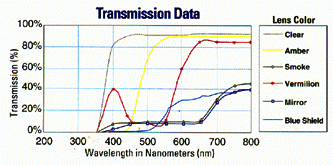UV LIGHT
Ultra-Violet radiation is divided into UVB radiation (290-315 nm) shorter wave lengths and UVA radiation (315-380 nm) longer wave lengths.
Here are a few facts about UV radiation.
-
UV causes photokerato conjunctivitis commonly known as snow blindness
-
UV contributes to and accelerates the development of cataracts
-
UV causes corneal degeneration and contributes to the development of pinquecula and pterygium
-
UV causes degeneration of retinal pigment epithelium (this accelerates "age related macular degeneration"- ARMD) which is a major cause of blindness in North America today
-
UV causes tumors of the eyelid. These squamous cell carcinomas are common and serious. A malignant melonoma will be fatal in most cases.
Protection from UV radiation (both UVA and UVB) is important, especially with our depleted ozone layer. You should understand that eye tissue does not develop a tolerance to UV radiation. No one is immune to its ocular effects. People with blonde hair and blue iris' are most vulnerable to UV damage. Damage to eye tissue by repeated exposure to UV radiation is incremental and irreversible. Some medications can increase your sensitivity to UV radiation. Some examples of these medications are tranquilizers, anti-hypertensives, diuretics, oral contraceptives, antipsychotics, antidiabetics, and antibiotics. With this background information you can now appreciate the value of UV inhibitors in spectacle lenses.
Spectacle lenses are commonly made from 3 materials: Crown Glass, CR Resin, and Polycarbonate. In terms of the best safety lenses, polycarbonate ranks and the top followed by CR39 resins and then a treated crown glass lens. The polycarbonate and CR39 resins lenses can have a scratch resistant coating applied and they are about half the weight of crown glass lenses. When comparing polycarbonate lenses to lens materials made from crown glass, it is interesting to note that clear and coated crown glass lenses provide no effective protection from UV radiation. Some solid (through the glass) tints offer partial UV radiation protection. CR39 resin lenses block UVB and therefore offer partial protection in their clear form. (A UV inhibitor can be added to block UVA in the CR39 material). Polycarbonate lenses block UVA and UVB (up to 380 nm) in the clear form.
SOURCES OF UV LIGHT
-
Low Pressure mercury lamps, such as fluorescence or "black lights"
-
Low pressure mercury lamps, such as actinic lamps
-
Low pressure mercury lamps, such as germicidal lamps
-
Medium pressure lamps, such as photochemical lamps
-
High pressure mercury lamps and metal halide lamps, such as sun lamps
-
High and very high pressure mercury and xenon lamps such as sun lamps, solaria, pulsed lamp systems
UV LIGHT AND THE EYE
In addition to visible light, the sun also radiates energy at higher and lower wavelengths, just as sounds can be too high, or low-pitched to hear. We can feel lower-energy radiation on our skin as heat. That's infrared (IR), beyond the red end of the color spectrum. Too much infrared can be harmful, but hazardous infrared light are not as common as other, high energy end of the spectrum, called ultra-violet. UV means "beyond blue".
Intense ultra-violet sources are common, like sunlight, tanning beds and welding arcs. But fluorescent lights and computer screens are not significant sources of ultra-violet light. There are three sites in the eye where UV often causes damage. At the cornea, sudden intense UV exposure can cause a "flash burn". This makes the cornea and iris sore for a day or two, such as a sunburn on the skin. A sore iris can be very painful in bright light. With enough exposure, the cornea turns hazy white, sometimes beyond its ability to heal. This is the mechanism of snow blindness. Slower, more chronic UV exposure is thought to promote a condition where membranes around the cornea grow too aggressively-pinguecula and pterygium.
The retina (the inner lining that perceives light) is very sensitive to ultra-violet. It develops defects, holes and blisters when exposed to substantial UV. Retinal problems after cataract surgery were diminished substantially when the FDA approved UV coatings on lens implants. Finally, the crystalline lens inside the eye can be demonstrated to change in response to ultra-violet, and any loss of transparency is technically a cataract. But the typical cataract has adaptive (beneficial) aspects, namely the side effect of protecting the sensitive retina. The lens turns yellow (the best color to block UV) and gets milky, measurable more opaque to ultra-violet. However, farmers and bookkeepers don't differ enormously in their incidence of cataracts.
There are situations where UV absorbing lenses are a good idea. If you spend a lot of time in sunlight, or on water, sand, snow, or around arc welders, you would likely benefit from UV protection.
There is seldom much UV inside a car, that's why photochromic (also known as polarized) lenses don't get very dark in the car.
If you have had cataract surgery, your surgeon can tell you whether or not your implant is UV protected. If not, you should already know that special protection is important.
The best protection comes from UV400 lens, with the UV absorber built into the material so it will not scratch off. Spectacle lenses made of glass are NOT good UV filters.
TRANSMISSION LEVELS


-
UV band goes up to 380nm
-
Our lenses filter out 99% of radiation below 385 nm
-
Our UV400 lenses filter out 99% below 400nm and 100% below 380nm
-
Full UV protection (UV400 lens is only needed when UV radiation source is significant)


